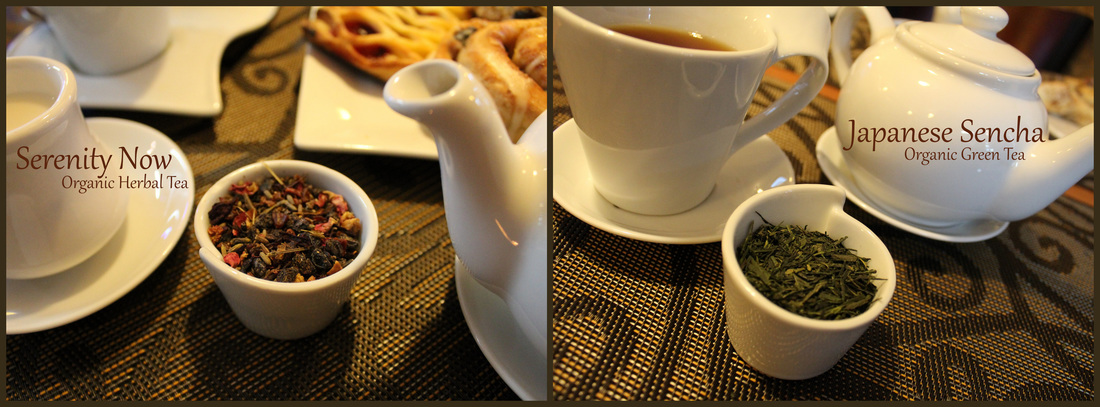Our Loose Leaf Tea
|
New! Serenity Now (Herbal)
Organic herbal tea A caffeine-free blend of currants, rosehips, lavender, spearmint, blueberries, quince, apple, hibiscus, rose petals and strawberries. Dating back to Ancient Egypt and Ancient China, herbal tea has been used for hundreds of years for its health benefits and great taste. |
New! Japanese Sencha (Green)
Organic green tea In 1738, Ujitawara, Kyoto, Soen Nagatani developed a new process of steam drying tea leaves. The new process, known as the Uji method, resulted in fresh, flavorful tea. It quickly replaced the traditional method of roasting and drying tea leaves. Sencha, an emerald-green tea that’s refreshing and smooth was the result, and is now Japan’s most popular tea. |
|
English Breakfast (Black) Sri Lankan black tea English Breakfast Tea was actually invented in Edinburgh, Scotland. A tea master by the name of Drysdale came up with the idea of marketing his blend as "Breakfast Tea". The concept soon spread to England where tea had become enormously popular. The English of the 19th Century were crazy for anything even remotely Chinese, where tea in it's most purest form originated. Tea houses in London began adding "English" to the name, and the tea became and remains one of the most popular teas in England. |
Earl Grey (Black) Black tea with cornflower petals and bergamot oil According to the Grey family, the tea was specially blended by a Chinese mandarin for Lord Grey, to suit the water at Howick Hall, the family seat in Northumberland, using bergamot in particular to offset the preponderance of lime in the local water. Lady Grey used it to entertain in London as a political hostess, and it proved so popular that she was asked if it could be sold to others, which is how Twinings came to market it as a brand. |
|
Chai (Black)
Organic black tea, cinnamon, ginger, licorice root, cardamom, cloves, vanilla, black pepper The history of chai tea dates back 5,000 years to the ancient courts of Siam and India. Legend has it that a king concocted a recipe in a quest to create a healing beverage. After that, authentic chai tea was used in the healing tradition of “ayurveda” alternative medicine. Along with massage, herbs, yoga and other healing elements, chai tea was consumed to naturally heal the body beginning in the Vedic period in India. The popularity of chai tea spread throughout South Asia and far into the Western World, continuing its growth today. |
Darjeeling (Black)
Second flush darjeeling tea from Darjeeling, India It was around 1834 when Lord William Bentinck appointed a committee "to consider the question of importing seeds and plants from China; to decide upon the most favourable localities for growing them..." Around 1835 seedlings and tea seeds were distributed to various parts of India, mostly in the hilly regions of the country. Dr. Campbell, a civil surgeon, was transferred from Kathmandu to Darjeeling in 1839 as the first superintendent of Darjeeling. At this time, there were hardly twenty families living in the entire tract of hills. Dr. Campbell brought China tea seeds from Kumaon hills of north India in the year 1841 and planted them near his residence in his Beechwood garden in Darjeeling, 2134 mtrs. above sea level. Seeing the success in the plantation of Darjeeling Tea, the government elected to put out Darjeeling Tea nurseries in these areas in the year 1847. |
Tie Kwan Yin (Oolong)
Organic Chinese Wuyi oolong tea from Fujian Province
Known as 'Lucky Tea', the legend follows:
Deep in the heart of Fujian's Anxi County, there was a rundown temple which held an iron statue of Guanyin (Kwan Yin), the Goddess of Mercy. Every day on the walk to his tea fields, a poor farmer named Mr. Wei would pass by and reflect on the temple's worsening condition. “Something has to be done,” thought Mr. Wei.
Being poor, he did not have the means to repair the temple. Instead, the farmer brought a broom and some incense from his home. He swept the temple clean and lit the incense as an offering to Guanyin. "It's the least I can do," he thought to himself. Twice a month for many months, he repeated the same tasks.
One night, Guanyin appeared to him in a dream. Guanyin told him of a cave behind the temple where treasure awaited. He was to take the treasure and share it with others. In the cave, the farmer found a single tea shoot. He planted it in his field and nurtured it into a large bush, from which the finest tea was produced. He gave cuttings of this rare plant to all his neighbors and began selling the tea under the name Tieguanyin, 'Tea of the Goddess of Mercy'.
Over time, Mr. Wei and all his neighbors prospered; the rundown temple of Guanyin was repaired and became a beacon for the region. Mr. Wei took joy in the daily trip to his tea fields, never failing to stop in appreciation of the beautiful temple.
Organic Chinese Wuyi oolong tea from Fujian Province
Known as 'Lucky Tea', the legend follows:
Deep in the heart of Fujian's Anxi County, there was a rundown temple which held an iron statue of Guanyin (Kwan Yin), the Goddess of Mercy. Every day on the walk to his tea fields, a poor farmer named Mr. Wei would pass by and reflect on the temple's worsening condition. “Something has to be done,” thought Mr. Wei.
Being poor, he did not have the means to repair the temple. Instead, the farmer brought a broom and some incense from his home. He swept the temple clean and lit the incense as an offering to Guanyin. "It's the least I can do," he thought to himself. Twice a month for many months, he repeated the same tasks.
One night, Guanyin appeared to him in a dream. Guanyin told him of a cave behind the temple where treasure awaited. He was to take the treasure and share it with others. In the cave, the farmer found a single tea shoot. He planted it in his field and nurtured it into a large bush, from which the finest tea was produced. He gave cuttings of this rare plant to all his neighbors and began selling the tea under the name Tieguanyin, 'Tea of the Goddess of Mercy'.
Over time, Mr. Wei and all his neighbors prospered; the rundown temple of Guanyin was repaired and became a beacon for the region. Mr. Wei took joy in the daily trip to his tea fields, never failing to stop in appreciation of the beautiful temple.
Credits
English Breakfast - http://www.mrbreakfast.com/ask.asp?askid=22
Chai - http://www.mightyleaf.com/tea-tips-chai-tea-history-and-traditions/
Earl Grey - http://en.wikipedia.org/wiki/Earl_Grey_tea
Tie Kwan Yin - http://en.wikipedia.org/wiki/Guanyin
Darjeeling - http://www.darjnet.com/darjeeling/darjeeling/history/tea/teaindus.html
Sencha - http://www.hibiki-an.com/contents.php/cnID/17
Herbal - https://www.revolutiontea.com/history-of-herbal-tea
Chai - http://www.mightyleaf.com/tea-tips-chai-tea-history-and-traditions/
Earl Grey - http://en.wikipedia.org/wiki/Earl_Grey_tea
Tie Kwan Yin - http://en.wikipedia.org/wiki/Guanyin
Darjeeling - http://www.darjnet.com/darjeeling/darjeeling/history/tea/teaindus.html
Sencha - http://www.hibiki-an.com/contents.php/cnID/17
Herbal - https://www.revolutiontea.com/history-of-herbal-tea


